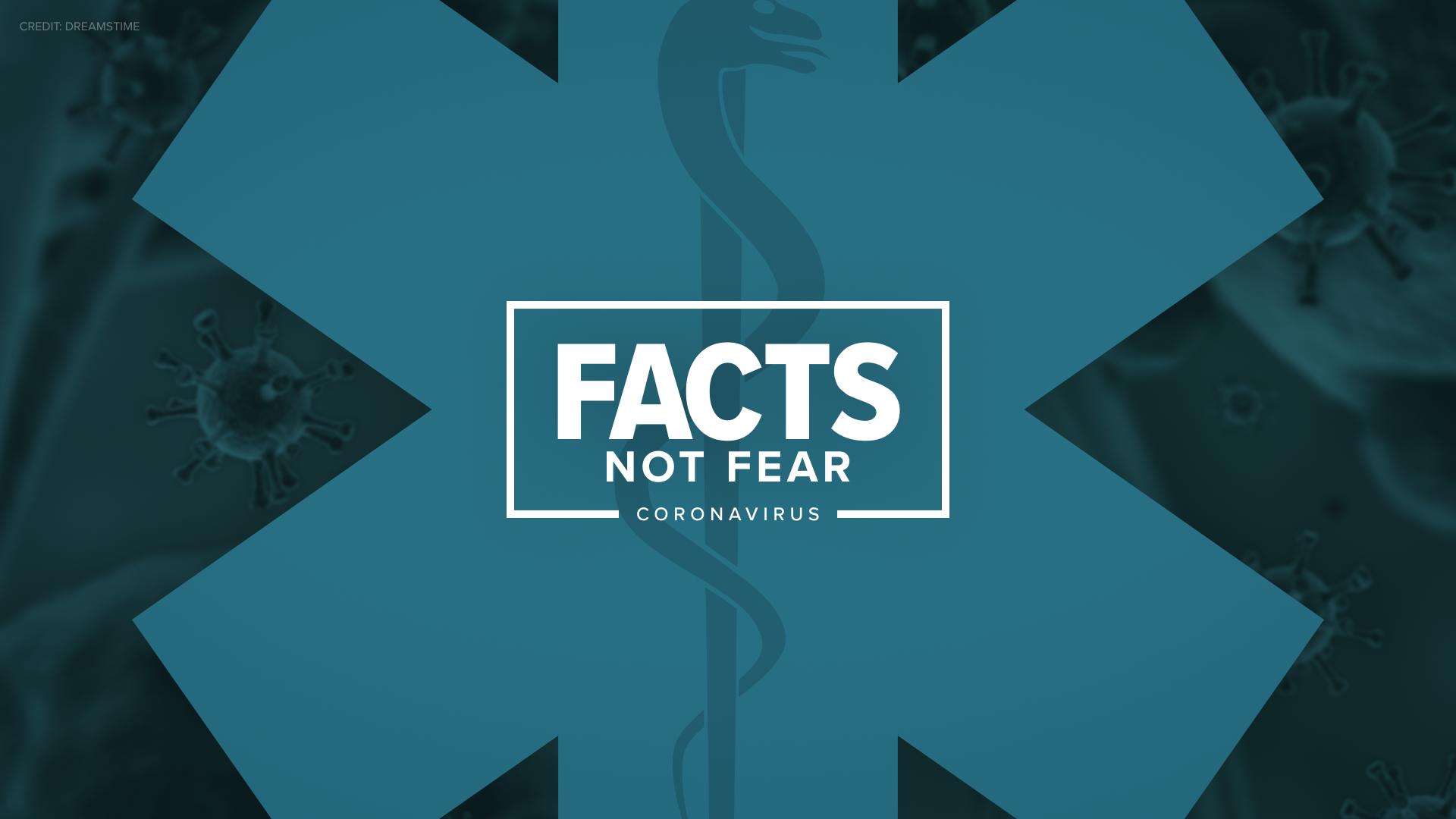HOW FAR HAS CORONAVIRUS SPREAD IN MINNESOTA AND WISCONSIN?
Coronavirus cases were first confirmed by lab test on March 6 in Minnesota, and Feb. 5 in Wisconsin. Since then, "community transmission" has been identified in both states, meaning the virus spreads from one person to another.
MDH maintains a regularly updated webpage with "Situation Updates," including the number of cases and deaths that have been reported, and where they occurred. The state also set up a COVID-19 data portal, with information about how to stay safe, what resources are out there for unemployment, and the status of Minnesota's health care supplies and ICU capacity.
The Wisconsin Department of Health Services keeps this page updated with details of how many people have tested positive, how many deaths have been reported, and more statistics about those cases.
The state of Minnesota has set up a hotline for general questions about coronavirus at 651-201-3920 or 1-800-657-3903, available 7 a.m. to 7 p.m. Wisconsin residents can text COVID19 to 211-211, visit 211Wisconsin.org, or call 211 with questions.
RELATED: How to practice social distancing
WHICH COUNTRIES/STATES HAVE CORONAVIRUS CASES?
COVID-19 coronavirus cases have been reported in countries around the world, including the United States.
A project from the Johns Hopkins Center for Systems Science and Engineering lets you track COVID-19 cases around the world using an interactive map. The map is best viewed on a desktop. Click here for a larger view from Johns Hopkins University.
The Associated Press has also created a map which tracks current cases in the United States, based on the data collected by Johns Hopkins.
HERE ARE THE SYMPTOMS OF CORONAVIRUS
According to the Centers for Disease Control, coronavirus patients have reported a mild to severe respiratory illness, with symptoms of cough, fever, and shortness of breath.
The CDC says those symptoms can appear within two days, or as long as 14 days after exposure.

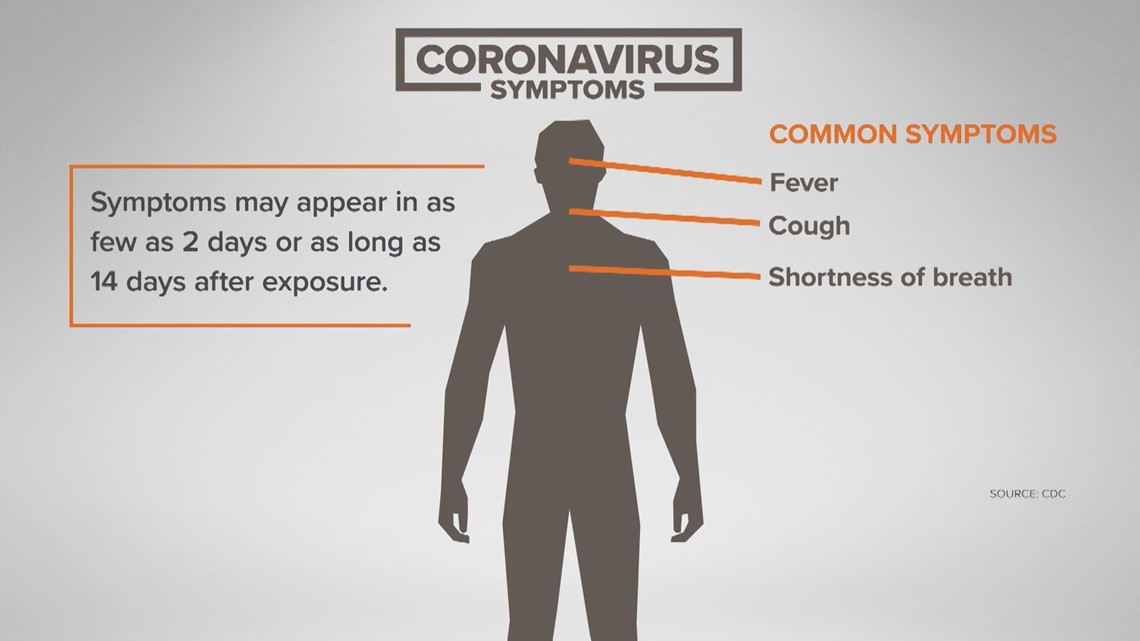


HOW DOES THE VIRUS SPREAD?
The CDC says the COVID-19 coronavirus is believed to spread mainly from person-to-person, particularly between people in close contact with one another (within about 6 feet) through respiratory droplets produced by coughing or sneezing. The CDC says those droplets can be inhaled, or end up in the mouths or noses of people who are nearby.
The CDC adds that it may be possible to get the virus by a person touching a contaminated surface or object, and then touching their own mouth, nose, or possibly their eyes, but this is not thought to be the main way the virus spreads.

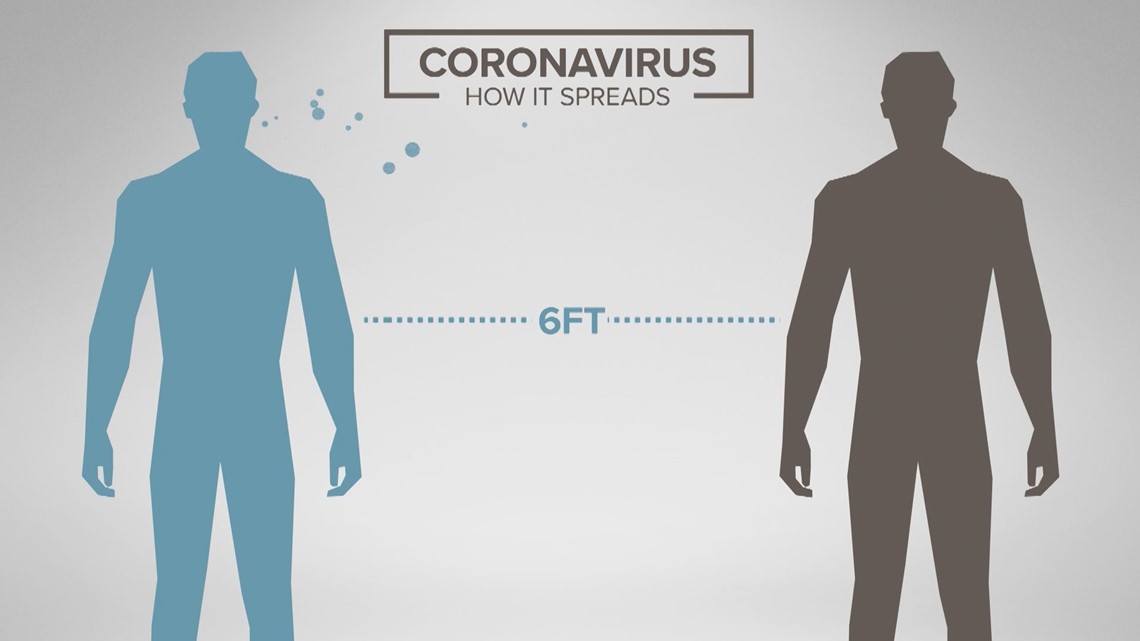
The CDC adds that people infected with COVID-19 are thought to be most contagious when they are most symptomatic (or in other words, when they are the sickest).
"Some spread might be possible before people show symptoms; there have been reports of this occurring with this new coronavirus, but this is not thought to be the main way the virus spreads," the CDC says on its website.
"It may be possible that a person can get COVID-19 by touching a surface or object that has the virus on it and then touching their own mouth, nose, or possibly their eyes, but this is not thought to be the main way the virus spreads," the CDC says.

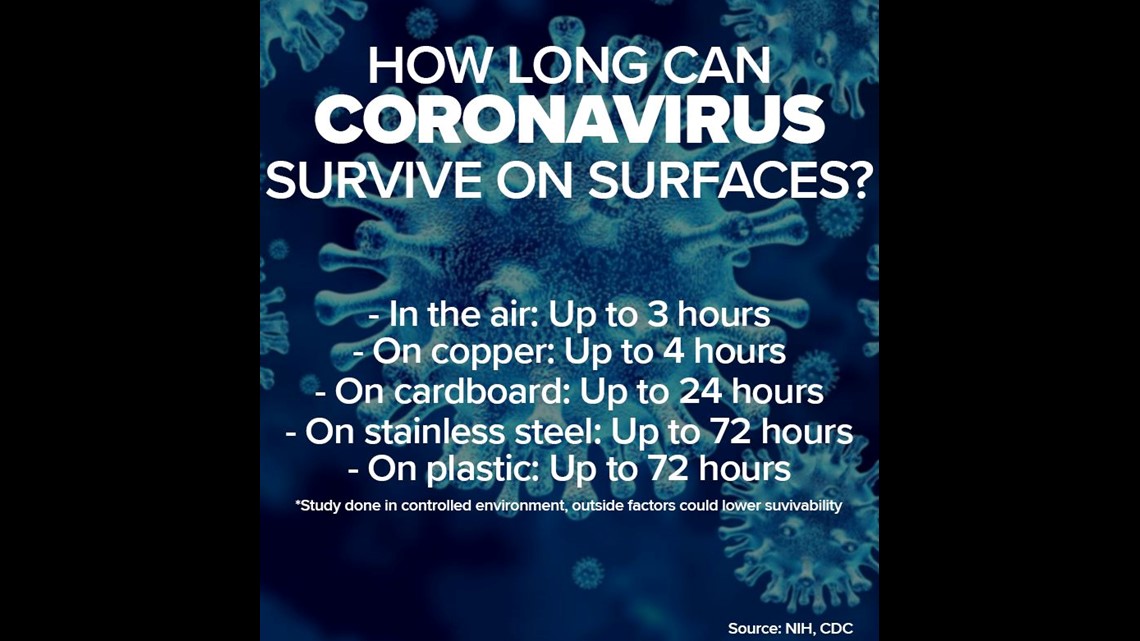
HOW IS CORONAVIRUS TREATED?
According to the CDC, at this time "there is no specific antiviral treatment recommended for COVID-19. People with COVID-19 should receive supportive care to help relieve symptoms."
The CDC advises people who think they have been exposed to contact their health care provider.
SHOULD I WEAR A FACE MASK?
The CDC has recommended that members of the public wear cloth face coverings out in public, especially in areas of significant community-based transmission. If you can't find a cloth mask, here's some information on how to make your own.
Health officials are urging the public not to wear or buy N95 respirators or surgical grade masks, because there is a global shortage and they are considered vital for health care workers and first responders.
The Minnesota Department of Health (MDH) has emphasized that masks do not protect the wearer - they keep the wearer from spreading their own germs.
"Your mask protects me, my mask protects you," says MDH Commissioner Jan Malcolm.
HOW DOCTORS TEST FOR CORONAVIRUS
According to CDC guidance for health professionals published in mid-February, doctors are advised to do a swab of a patient's nose and throat, as well as collecting a sputum sample. The sample is then sent for lab testing.
The Minnesota Department of Health Public Health Laboratory was the first lab in the state to test for COVID-19, but now they have help from external labs, including the Mayo Clinic.
HOW SEVERE IS THE ILLNESS?
Numbers from the World Health Organization showed a survey of coronavirus patients from Feb. 16-24 showed mild symptoms in 80% of cases, with severe illness reported in 13.8% of cases, and critical illness in 6.1% of cases.

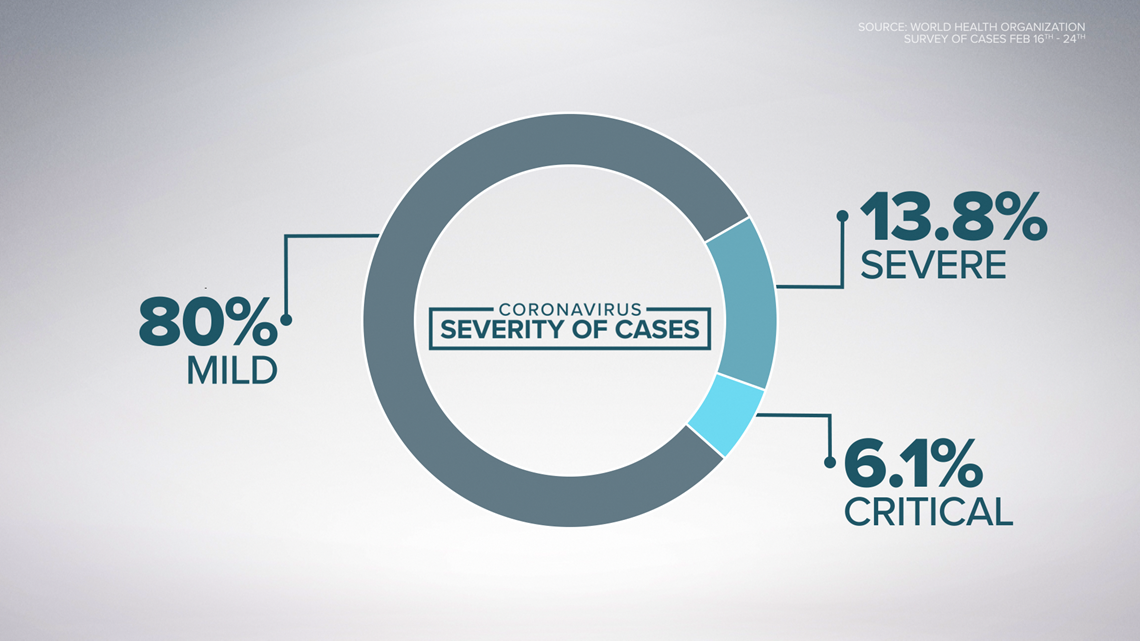
WHAT ARE 'UNDERLYING CONDITIONS'?
Health officials have said certain "underlying conditions" could make COVID-19 more serious for people of any age. The Minnesota Department of Health has published this list:
- Blood disorders (e.g., sickle cell disease or on blood thinners).
- Chronic kidney disease as defined by your doctor. Patient has been told to avoid or reduce the dose of medications because kidney disease, or is under treatment for kidney disease, including receiving dialysis.
- Chronic liver disease as defined by your doctor. (e.g., cirrhosis, chronic hepatitis) Patient has been told to avoid or reduce the dose of medications because liver disease or is under treatment for liver disease.
- Compromised immune system (immunosuppression) (e.g., seeing a doctor for cancer and treatment such as chemotherapy or radiation, received an organ or bone marrow transplant, taking high doses of corticosteroids or other immunosuppressant medications, HIV or AIDS).
- Current or recent pregnancy in the last two weeks.
- Endocrine disorders (e.g., diabetes mellitus).
- Metabolic disorders (such as inherited metabolic disorders and mitochondrial disorders).
- Heart disease (such as congenital heart disease, congestive heart failure and coronary artery disease).
- Lung disease including asthma or chronic obstructive pulmonary disease (chronic bronchitis or emphysema) or other chronic conditions associated with impaired lung function or that require home oxygen.
- Neurological and neurologic and neurodevelopment conditions (including disorders of the brain, spinal cord, peripheral nerve, and muscle such as cerebral palsy, epilepsy [seizure disorders], stroke, intellectual disability, moderate to severe developmental delay, muscular dystrophy, or spinal cord injury).
HERE'S WHAT YOU CAN DO TO PREVENT SPREADING THE VIRUS
The Minnesota Department of Health has issued recommendations for people within the state to use "community mitigation" strategies. Those continue to evolve and will be updated here.
The CDC recommends these everyday lifestyle tips for avoiding the spread of any type of respiratory virus:
- Avoid close contact with people who are sick.
- Stay home as much as possible, and put distance between yourself and other people.
- Avoid touching your eyes, nose, and mouth with unwashed hands.
- Wear a cloth face cover when around others, since it's possible you could spread COVID-19 even if you do not feel sick. This is not a substitute for social distancing of at least 6 feet.
- Wash your hands often with soap and water for at least 20 seconds. Use an alcohol-based hand sanitizer that contains at least 60% alcohol if soap and water are not available.
- Cover coughs and sneezes, using a tissue or the inside of your elbow.
- Clean and disinfect frequently touched objects and surfaces every day using a regular household cleaning spray or wipe.
HERE'S WHAT YOU CAN DO IF YOU ARE SICK
The CDC says to take these steps to avoid spreading a respiratory illness:
• Stay home when you are sick, except to get medical care.
• Call ahead before visiting your doctor so the office can take steps to keep other people from being exposed.
• Separate yourself from other people and animals in your home.
• Cover your cough or sneeze with a tissue, then throw the tissue in the trash.
• Clean and disinfect frequently touched objects and surfaces.
• Avoid sharing personal household items like cups, towels or bedding.
HERE'S WHAT YOU CAN DO TO PREPARE
Infectious disease specialist Dr. Michael Osterholm says it's a good idea to stock up on essential medication, supplies and non-perishable food, but he said the first thing everyone should do is talk to your loved ones and make a plan.
"What are they going to do if they get ill? Who will they call? How will they access the medical care system? Who is watching out for grandma?" Osterholm said. "We need, right now, to really develop communication plans so that we're checking on people every day."
The CDC also recommends creating a household plan of action as part of your preparations:
• Meet with household members, relatives, and even neighbors about emergency planning.
• Plan ways to care for those who might be at greater risk.
• Create an emergency contact list.
• Practice good personal health habits.
• Choose a room in your home that can be used to separate someone who is sick from those who are healthy.
• Learn the emergency plans for your child's school or daycare.
• Learn about your employer's emergency operations plan.
SHOULD YOU CANCEL YOUR TRAVEL PLANS?
When it comes to travel within the United States, the CDC says they generally don't issue travel advisories or restrictions. However, they do say that crowded travel settings, like airports, increase your risk of getting COVID-19 if other infected travelers are present. There are also areas of the U.S. that are experiencing more community spread than others. The CDC's guidance for travelers is updated frequently due to the "rapidly evolving" situation, so check out the latest recommendations here.
"Stay at home" orders may also affect travel restrictions differently in each state. Wisconsin's "Safer at Home" order bans nonessential travel. Minnesota's "Stay at Home" order limits Minnesotans' movements to essential needs, although it doesn't ban travel in and out of the state.
As for international travel, on March 19 the State Department issued a level 4 travel advisory for U.S. citizens to avoid all international travel due to the global impact of COVID-19. Level 4 is the highest level of advisory and means "Do not travel."
"In countries where commercial departure options remain available, U.S. citizens who live in the United States should arrange for immediate return to the United States, unless they are prepared to remain abroad for an indefinite period," the advisory says.
The State Department has also been advising U.S. citizens not to travel on cruise ships, especially older adults and people with underlying health conditions. They also recommend avoiding crowded places and non-essential travel, like long plane trips.
WHAT HELP IS AVAILABLE FOR THOSE OUT OF WORK?
With all of the businesses closing or limiting services in response to coronavirus, Minnesota Gov. Tim Walz has eased some of the requirements for receiving unemployment. Normally you have to be out of work for at least a week, and be searching for a job to qualify, but those requirements are waived during the pandemic.
The best way to apply is online at UIMN.org, because the call centers are mainly designed for people who don't have computers, or don't read English.
Minnesota's unemployment insurance program provides up to 26 weeks of benefits, with checks equal to 50% of your normal paycheck up to $740 per week. That's generous compared to most states.
It normally takes one to two weeks for the first check to arrive, but officials are asking for people to be patient because of the sudden high demand.
There's also a system to help workers who aren't laid off but have their hours cut back substantially. Employers can apply to the state's Shared Work program to get partial unemployment to augment workers' pay.
Specific financial relief is available to Minnesota's veterans, and for small businesses. More information for workers and businesses can be found at mn.gov/deed.
WHAT ABOUT PETS?
The CDC says anyone sick with COVID-19 coronavirus should restrict contact with pets just like people.
"Although there have not been reports of pets becoming sick with COVID-19 in the United States, it is still recommended that people sick with COVID-19 limit contact with animals until more information is known about the new coronavirus," the CDC says.
The CDC also says at this time, there is no evidence that the virus can spread to people from the skin or fur of pets.
Researchers in Hong Kong reported that cats and dogs can't pass the coronavirus to humans, but they can test positive for low levels of the pathogen if they catch it from their owner.
WHAT IF I WITNESS RACISM OR XENOPHOBIA?
Minnesota state officials say they've seen an increase in reports of racism and xenophobia during the COVID-19 pandemic, especially aimed at the Asian American community.
The state has set up a Discrimination Helpline at 1-833-454-0148 for people to call and report bias and discrimination that they've either experienced or witnessed. They can also submit this online form.
Translation services are available on the helpline. If you are the victim of a crime, including a hate crime, or fear for your safety, you should still call 911 immediately.
STAY INFORMED
The Centers for Disease Control has an in-depth frequently asked questions (FAQ) section on its website with additional answers for people looking for more information about COVID-19 coronavirus.
The Minnesota Department of Health has set up a data portal with information about spread, resources for the public, and answers to questions about everything from sickness to unemployment.
Wisconsin has information about the outbreak in the state, restrictions on gatherings and activities, and more resources for the public here.
KARE 11’s coverage of the coronavirus is rooted in Facts, not Fear. Visit kare11.com/coronavirus for comprehensive coverage, keep track of cases in Minnesota and Wisconsin, learn more about the symptoms, and keep tabs on the cases around the world here. Have a question? Text it to us at 763-797-7215. And get the latest coronavirus updates sent right to your inbox every morning. Subscribe to the KARE 11 Sunrise newsletter here. Help local families in need: www.kare11.com/give11.

